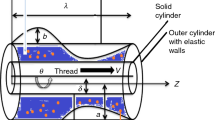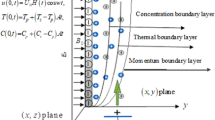Abstract
An electro-osmotic particulate flow is presented in this article. Fluid-particle interaction is simulated in bulged out cavity at the center. Casson non-Newtonian fluid model serves as the base liquid, while spherical & homogenous metallic particles are used to form a granular suspension. Particulate flow is modeled by using Navier–Stokes equations which assist to trace the motion of the particles, as well. The electric potential within this volume is governed by “The Poisson equation”. Moreover, the local charge density may be related to the electric potential through the “Boltzmann distribution”. In addition to this, lubrication effects are applied to take care of the skin friction of the walls. The main objective of this study is to highlight the application of electro-osmosis, such as biophysics, geomechanics, medicine, microchips, and oil and gas production. Since, electro-osmotic flow arises from the formation of an electrical double layer at solid–liquid interface. Therefore, this is a significant phenomenon in chemical separation techniques; in particular, to expedite the fluid flow in oil rigs and clay-rich soils in petroleum industries. The application of electricity stimulates the fluid to flow out of the pores of the soil, due to the ions with a positive charge.






Similar content being viewed by others
References
O’Neill ME, Ranger KB, Brenner H (1986) Slip at the surface of a translating–rotating sphere bisected by a free surface bounding a semi-infinite viscous fluid: removal of the contact-line singularity. Phys Fluids 29(4):913–924
Besant WH (1859) A treatise on hydrostatics and hydrodynamics. Bell, Deighton
Ellahi R, Hayat T, Mahomed FM, Zeeshan A (2010) Exact solutions for flows of an Oldroyd 8-constant fluid with nonlinear slip conditions. Commun Nonlinear Sci Numer Simul 15(2):322–330
Thompson PA, Troian SM (1997) A general boundary condition for liquid flow at solid surfaces. Nature 389(6649):360–362
Richardson S (1973) On the no-slip boundary condition. J Fluid Mech 59(4):707–719
CLMH Navier (1823) Memoires de l’Academie royale des sciences de I’Institut de France 1(1823): 414-416
Švec O, Skoček J (2013) Simple Navier’s slip boundary condition for the non-Newtonian Lattice Boltzmann fluid dynamics solver. J Nonnewton Fluid Mech 199:61–69
Nazeer M, Ali N, Ahmad F, Latif M (2020) Numerical and perturbation solutions of third-grade fluid in a porous channel: boundary and thermal slip effects. Pramana 94(1):1–15
Irfan M, Nazeer M, Hussain F, Siddique I (2022) Heat transfer analysis in the peristaltic flow of Casson nanofluid through asymmetric channel with velocity and thermal slips: applications in a complex system. Int J Modern Phys B. 36(32):2250231
Nazeer M, Irfan M, Hussain F, Siddique I (2016) Entropy generation analysis in blood-gold casson nanofluid through horizontal wavy channel with velocity and thermal slips: applications in skin diseases. J Comp Biophy Chem 18:123
Choi S U, & Eastman J A (1995) Enhancing thermal conductivity of fluids with nanoparticles (No. ANL/MSD/CP-84938; CONF-951135–29). Argonne National Lab.(ANL), Argonne, IL (United States)
Nazir MW, Javed T, Ali N, Nazeer M, Khan MI (2022) Theoretical investigation of thermal analysis in aluminum and titanium alloys filled in nanofluid through a square cavity having the uniform thermal condition. Int J Modern Phys B. 36(22):2250140
Nazir MW, Javed T, Ali N, Nazeer M (2021) Effects of radiative heat flux and heat generation on magnetohydodynamics natural convection flow of nanofluid inside a porous triangular cavity with thermal boundary conditions. Numer Methods Partial Differ Equ. https://doi.org/10.1002/num.22768
Waqas M, Hayat T, Alsaedi A (2019) A theoretical analysis of SWCNT–MWCNT and H2O nanofluids considering Darcy-Forchheimer relation. Appl Nanosci 9(5):1183–1191
Dogonchi AS, Hashemi-Tilehnoee M, Waqas M, Seyyedi SM, Animasaun IL, Ganji DD (2020) The influence of different shapes of nanoparticle on Cu–H2O nanofluids in a partially heated irregular wavy enclosure. Physica A 540:123034
Jbeili M, Zhang J (2022) System-dependent behaviors of nanofluids for heat transfer: a particle-resolved computational study. Comput Particle Mech 23:1–16
Han S, Wang C, Liu X, Li B, Gao R, Li S (2023) A random algorithm for 3D modeling of solid particles considering elongation, flatness, sphericity, and convexity. Comput Particle Mech 10(1):19–44
Osuji NI, Zhang J, Tagne MD (2022) Numerical simulation on the effect of particle shape on mechanical response of proppants in horizontal fractures. Comput Particle Mech 9(3):513–523
Shi QH, Ahmed B, Ahmad S, Khan SU, Sultan K, Bashir MN, Chung JD (2021) Dual solution framework for mixed convection flow of Maxwell nanofluid instigated by exponentially shrinking surface with thermal radiation. Sci Rep 11(1):15944
Hussain F, Nazeer M, Ghafoor I, Saleem A, Waris B, Siddique I (2022) Perturbation solution of couette flow of casson nanofluid with composite porous medium inside a vertical channel. Int. J. Nanosci, 13(4):23–44
Hussain F, Subia GS, Nazeer M, Ghafar MM, Ali Z, Hussain A (2021) Simultaneous effects of Brownian motion and thermophoretic force on eyring-powell fluid through porous geometry. Zeitschrift für Naturforschung A 76(7):569–580
Kong W, Zhu K, Lu X, Jin J, Ni M (2021) Enhancement of lithium-ion battery thermal management with the divergent-shaped channel cold plate. J Energy Storage 42:103027
Javid K, Ali N, Asghar Z (2019) Rheological and magnetic effects on a fluid flow in a curved channel with different peristaltic wave profiles. J Braz Soc Mech Sci Eng 41(11):483
Asghar Z, Ali N, Javid K, Waqas M, Dogonchi AS, Khan WA (2020) Bio-inspired propulsion of micro-swimmers within a passive cervix filled with couple stress mucus. Comput Methods Programs Biomed 189:105313
Asghar Z, Ali N, Javid K, Waqas M, Khan WA (2021) Dynamical interaction effects on soft-bodied organisms in a multi-sinusoidal passage. European Phys J Plus 136:1–17
Asghar Z, Shah RA, Shatanawi W, Ali N (2022) A theoretical approach to mathematical modeling of sperm swimming in viscoelastic Ellis fluid in a passive canal. Archiv Appl Mech 28:1–10
Asghar Z, Saif RS, Ali N (2022) Investigation of boundary stresses on MHD flow in a convergent/divergent channel: an analytical and numerical study. Alex Eng J 61(6):4479–4490
Xu YJ, Nazeer M, Hussain F, Khan MI, Hameed MK, Shah NA, Chung JD (2021) Electro-osmotic flow of biological fluid in divergent channel: drug therapy in compressed capillaries. Sci Rep 11(1):1–13
Asghar Z, Waqas M, Gondal MA, Khan WA (2022) Electro-osmotically driven generalized Newtonian blood flow in a divergent micro-channel. Alex Eng J 61(6):4519–4528
Ellahi R, Hussain F, Asad Abbas S, Sarafraz MM, Goodarzi M, Shadloo MS (2020) Study of two-phase Newtonian nanofluid flow hybrid with Hafnium particles under the effects of slip. Inventions 5(1):6
Hussain F, Ellahi R, Zeeshan A (2018) Mathematical models of electro-magnetohydrodynamic multiphase flows synthesis with nano-sized hafnium particles. Appl Sci 8(2):275
Nazeer M, Hussain A, Hameed MK (2022) Impact of nano metallic particles and magnetic force on multi-phase flow of third-grade fluid in divergent channel: analytical study. Int J Model Simul. https://doi.org/10.1080/02286203.2022.2088023
Saleem S, Subia GS, Nazeer M, Hussain F, Hameed MK (2021) Theoretical study of electro-osmotic multiphase flow of Jeffrey fluid in a divergent channel with lubricated walls. Int Commun Heat Mass Transfer 127:105548
Ramesh K, Patel A, & Rawal M (2020) Electroosmosis and transverse magnetic effects on radiative tangent hyperbolic nanofluid flow through porous medium. Int J Ambient Energy 1–8
Ramesh K, Kumar D, & Waqfi D (2021) Significance of magnetohydrodynamics and modified Darcy's law on the electroosmotic propulsion of viscoelastic radiative nanofluid in a microchannel. Special Topics & Rev Porous Media: Int J 12(5)s
Kumar D, Ramesh K, Chandok S (2019) Influence of an external magnetic field on the flow of a casson fluid in micro-annulus between two concentric cylinders. Bull Brazilian Mathemat Soc, New Ser 50:515–531
Javed T, Ahmed B, Hamid AH, Sajid M (2018) Numerical analysis of peristaltic transport of Casson fluid for non-zero Reynolds number in presence of the magnetic field. Nonlinear Eng 7(3):183–193
Ahmed BILAL, Javed TARIQ, Sajid MUHAMMAD (2018) Peristaltic transport of blood in terms of Casson fluid model through a tube under impact of magnetic field for moderate Reynolds number. Imaging Sci J 14:101–113
Ellahi R, Zeeshan A, Hussain F, Abbas T (2019) Thermally charged MHD bi-phase flow coatings with non-Newtonian nanofluid and hafnium particles along slippery walls. Coatings 9(5):300
Nazeer M, Alqarni MZ, Hussain F, Saleem S (2023) Computational analysis of multiphase flow of non-Newtonian fluid through inclined channel: heat transfer analysis with perturbation method. Comput Particle Mech. https://doi.org/10.1007/s40571-023-00569-y
Acknowledgement
The authors extend their appreciation to the Deanship of Scientific Research at King Khalid University for funding this work through research groups program under Grant No. R.G.P2/115/44.
Author information
Authors and Affiliations
Corresponding author
Ethics declarations
Conflict of interest
The authors have no conflict of interest related to this manuscript.
Additional information
Publisher's Note
Springer Nature remains neutral with regard to jurisdictional claims in published maps and institutional affiliations.
Rights and permissions
Springer Nature or its licensor (e.g. a society or other partner) holds exclusive rights to this article under a publishing agreement with the author(s) or other rightsholder(s); author self-archiving of the accepted manuscript version of this article is solely governed by the terms of such publishing agreement and applicable law.
About this article
Cite this article
Duraihem, F.Z., Nazeer, M., Hussain, F. et al. Electro-osmotic particulate flow of non-Newtonian fluid in a bulged out cavity with lubrication: electro-osmotic dewatering approach. Comp. Part. Mech. 10, 1771–1780 (2023). https://doi.org/10.1007/s40571-023-00588-9
Received:
Revised:
Accepted:
Published:
Issue Date:
DOI: https://doi.org/10.1007/s40571-023-00588-9




